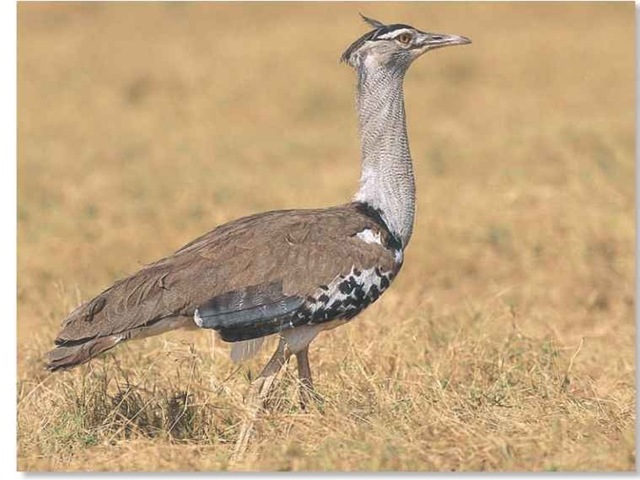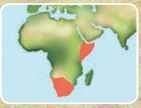ORDER
Gruiform.es
FAMILY
Otididae
GENUS & SPECIES
KEY FEATURES
• At nearly 40 lbs. and with a wingspan of nearly 8′, the kori bustard is one of the world’s heaviest flying birds
• The bustard will breed in an area just after animal herds have moved through, possibly looking for stirred-up insects to feed its young
where in the world!
Found in eastern and southern Africa; stretching from southern Angola and Namibia east through Botswana to southern Zimbabwe
Lifecycle
Both sexes of the kori are well camouflaged with their cryptic plumage, but the polygamous male invites attention by inflating his neck and ruffling his neck feathers.
HABITAT
The kori bustard prefers flat, arid and mostly open country, generally below 700′, with a short herb layerThe bird typically favors locations where the grass is not too long and where stony outcrops are present. It frequents grassland, bushveld, scrubland and savannahs, as well as floodplains, duneland and fossil valleys. The bustard doesn’t shy away from man-made habitats, such as wheat fields. During the hot, dry season in Kenya, many birds move into woodland.
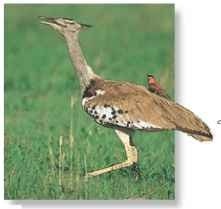
A Hitching a ride On the plains, a bustard gives a bee eater a ride.
Plant materials consumed by the bustard include the gumlike sap of acacia trees, which may be the basis for the kori bustard’s Afrikaans name Gompou, or “rubber peacock.”
Prehistoric man seems to have valued the kori bustard; cave drawings and rock engravings feature the , bird as game. Currently, the kori bustard features prominently in the dances and songs of Botswana’s African bushmen.
FOOD & FEEDING
Equipped with an all-purpose bill, the kori bustard is an opportunistic feeder The bustard is well known for taking advantage of swarming locusts and grasshoppers, and after bush fires has been known to feed on the victims, including dead and dying insects as well as vertebrates, mainly small snakes and lizards. Additionally, the bird exploits a wide range of vegetable and h animal resources, such as ki seeds, berries, bulbs, Acacia gum, snails, rodents and small birds. In fact, research has shown that vegetable matter, ncluding seeds, berries and -oots, makes up a surprisingly arge proportion of the kori Dustard’s extremely varied diet.
WINE AND DINE
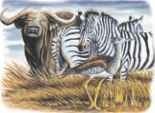
Join the crowd…
The kori is not afraid of larger animals, and actually nests in areas where herds have passed through.
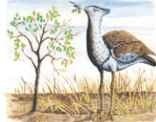
Salad with dinner…
The kori bustard’s sharp bill can also be used to peck at a small shrub, where it pulls off leaves.
BEHAVIOR
The kori bustard male exhibits grand and vibrant displays, most notably its strutting and booming call. During the strutting “balloon display” the male gulps air and inflates his gular pouch, an expanded area of the bird’s esophagus, or gullet. The pouch can be inflated to four times its normal size and held in this inflated state for an indefinite period. The bird’s “booming” call consists of three pairs of drumlike sounds: ump-ump, ump-ump, ump-ump.The kori bustard often associates with herds of large ungulates, such as wildebeest or zebras; the bird feeds on disturbed insects or on insects, such as the dung beetle, that are attracted to the dung piles left behind by these large animals.
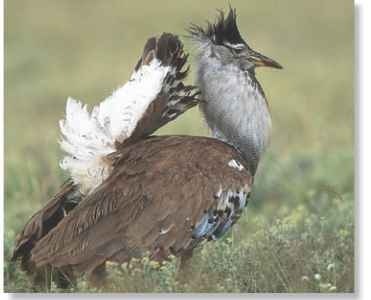
A Balloon display The male bustard can greatly inflate his neck.
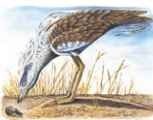
Sight and snatch…
Striking out at a dung beetle, the kori bustard uses its bill to snatch the tasty insect.
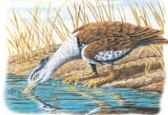
After-dinner drink
A thirsty bustard crouches at a small pool in its grassland home and drinks by filling its bill.
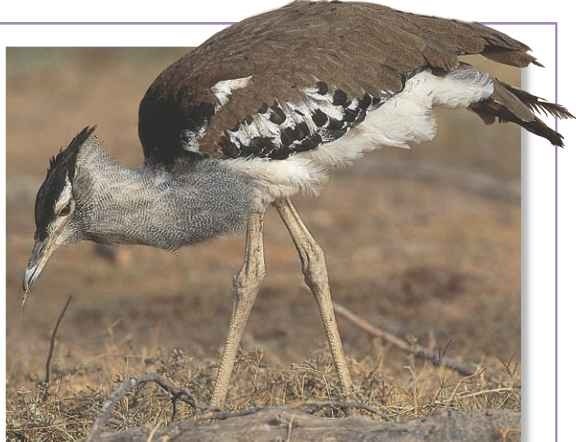
BREEDING
The kori bustard breeds from September to February in South Africa and December through August (depending on the rains) in East Africa. In fact, in East Africa, breeding success is greater when the wet season is longer. Males mate with several females, and while courting, the male walks slowly around the female or stands within 30′ of her; bowing with his body tilted forward and neck inflated; the head never reaches below the level of the shoulders. The booming display is performed with a fully inflated neck, the wings drooping, and the tail lowered so as to form a straight line with the wings. The nest is built by the female; it is often a simple scrape on the ground with a thin lining of grass. Nests may be built near rocks or a clump of grass, sometimes in partial shade. The bustard will often breed in an area just after herds have moved through; there, they find fresh insects for their young, which have been stirred up by the mammals. The female usually lays two eggs,but only one in drier years. The incubation period lasts around 25 days, and chicks are capable of flight by 5 weeks of age.
► Dazzling dance Bustards perform-an elaborate courtship dance.
CONSERVATION
The kori bustard is not globally threatened, but is listed on CITES Appendix II. If undisturbed, the bird can still be common, as it is in parts of Botswana. Around 5,000 individuals inhabit Zimbabwe, but the species is declining there due to habitat destruction, hunting pressure and disturbance.The kori bustard is also threatened in South Africa for the same reasons.
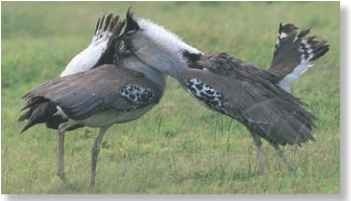
PROFILE
Kori Bustard
The kori bustard’s large size deters many predators; a walker rather than a runner or flier, it sometimes passes weeks without taking wing at all.
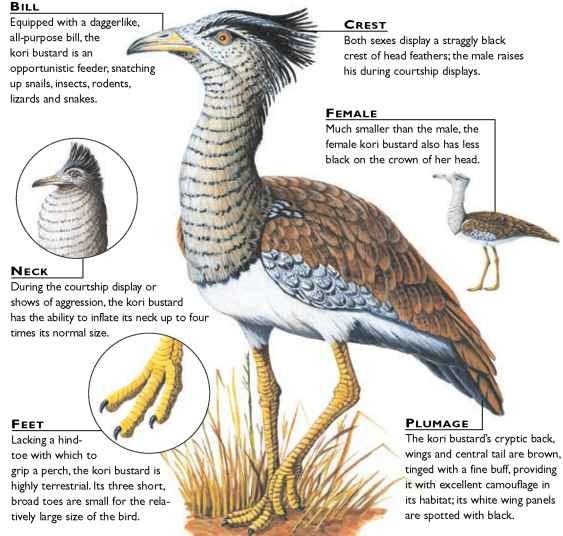
CREATURE COMPARISONS
At 47″, the Australian bustard (Ardeotis australia) is roughly the same size as the kori bustard. Its cryptic plumage is also similar; the back, wings and central tail of the Australian bustard are brown with fine, dark marbling, but its neck spots look more like freckles, in contrast to the kori bustard’s bars. Both birds inflate their necks during courtship displays; in addition, the Australian bustard’s throat pouch nearly touches the ground in its dramatic “balloon display.” The birds’ ranges are different: the Australian bustard is found in dense grassland in Australia and New Guinea, while the kori bustard makes its home in the open plains of Africa.
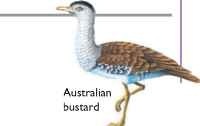
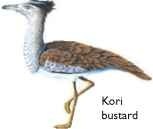
| vital statistics Weight About 40 lbs. |
|
| Length | 4.5′ |
| Wingspan | 8 |
| Sexual Maturity | Probably 1 year |
| Breeding Season | September-February in southern Africa; December through August in East Africa |
| Number of Eggs | 1-3 |
| Incubation Period | 25 days |
| Fledging Period | 4-5 weeks |
| Breeding [Interval | 1 year |
| Typical Diet | Seeds, lizards and snails |
| Lifespan | Unknown |
Related species
• There are 11 genera and 25 species in the family Otididae. The kori bustard is 1 of 4 species in the genus Ardeotis, which also contains the Arabian bustard, A. arabs, the Great Indian bustard, A. nigriceps, and the Australian bustard, A. australis. There are a variety of bustard relatives in the order Gruiformes, including trumpeters, rails, ^ buttonquails and cranes.
